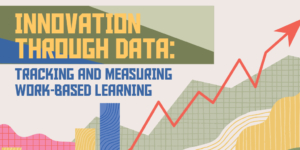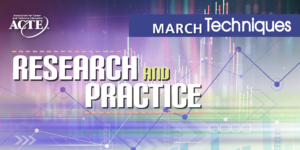Work-based learning (WBL) is a core feature of high-quality career and technical education (CTE). In fact, WBL is one of the 12 elements in the ACTE Quality CTE Program of Study Framework. And states, community colleges, school districts, high schools and others invest significant resources in WBL. In addition, Perkins V designated WBL as one of three new secondary-level CTE quality indicators for state accountability purposes.
Despite this enthusiasm for WBL as a valuable part of CTE, there is little evidence tying WBL to student outcomes. Recent years have seen an increasing amount of positive evidence for the impact of CTE on student outcomes (Brunner et al., 2021; Edmunds et al., 2022). But the lack of data on WBL participation prevents us from understanding its contribution. The absence of research is not due to want of interest. Rather, it can be attributed to the complex and varied nature of WBL experiences and the inherent difficulties in collecting systematic, high-quality data. Collecting accurate and complete data on the numbers and types of activities students experience, as well as the duration and intensity of the experiences, among other aspects, is surely challenging.
The Institute of Education Sciences, U.S. Department of Education, funded the CTE Research Network in 2018 to expand the evidence base for CTE, with a focus on research that can show the causal impact of CTE on student outcomes.
This article presents research on promising practices and innovations in WBL data collection and use in six school districts. The six featured districts were selected based on the strength of their WBL data collection systems and procedures, as well as their representing a diverse set of approaches and settings. CTE Research Network participants conducted 24 interviews across the six districts, speaking with a variety of staff on topics such as:
- Platform design
- Data elements collected
- Staff involvement, training and buy-in
- Needed resources
- Use and sharing of data
Data platforms and systems
Appoquinimink School District in Delaware uses The Agricultural Experience Tracker (AET for CTE) to centralize tracking of participation, hours and skill gains. The district had used the AET database for its Agriculture, Food, and Natural Resources pathways for many years and began to implement the system for all students in fall 2022.
Collier County School District in Florida implemented a WBL data collection system through its NAF career academies. The NAF WBL Participation Tracker and Reflection Form allow teachers and other staff to monitor and reflect on overall types and intensity of WBL participation, including student reflections.
Fresno Unified School District in California tracks WBL participants through its TitanWBL system, which was custom-built for the district and launched during the 2022–23 academic year to track and report on a wide range of WBL activities.
Lowndes County Schools in Georgia developed a digital system of free or low-cost tools, primarily through Google tools, to manage all aspects of WBL. This includes applications, enrollment, placements, hours worked, wages and earned credentials.
Muskego-Norway School District in Wisconsin developed its WBL data collection system using Qualtrics, an online survey and analysis platform that is managed by the WBL coordinator.
Poudre School District R-1 in Colorado introduced the Xello online platform in 2020 to track student interests and WBL activities. The district also uses Xello to house students’ career interests related to their individualized learning plans.
Featured practices
The profiled districts track many different data elements on students’ participation in WBL. They categorize the type of WBL experience in which the student engages across the continuum. Districts also document, for example, the dates and hours that students participate, the associated career cluster, the employer and their company, and other elements.
One key practice is preserving a longitudinal record of student experiences over time. The districts capture individual student-level information about WBL participation over time. This helps to build a profile of student experiences as they evolve through high school. Districts also may register students’ career interests to align opportunities to those interests and track how they may change.
When talking about student outcomes from WBL, practitioners often discuss the high value of employability skills. WBL experiences are designed to develop these skills, and they are a promising place to look at short-term outcomes for research purposes. These skills, however, have been difficult to measure and document in a systematic way.
Staff resources
All six districts employ at least one full-time WBL coordinator. Their primary role involves developing and implementing the WBL programs. But these staff members allocate some of their time to data-related tasks. These include learning how to use the technology; training teachers, students or employers; generating reports from data systems; and checking data entered by students or other users.
Quality assurance
Districts vary in the ways they approach monitoring data quality. On the entry side, some districts place greater restrictions on who may enter data. In other districts, multiple users enter data to reduce burden on any one group and collect many viewpoints. In both approaches, districts had formal or informal systems in place to monitor quality.
Using the data
Staff use their WBL data to plan, communicate the value of WBL, recruit industry partners, improve programs, and monitor progress toward goals for access and equity. Interviewees described tracking WBL participation data to uncover inequities in WBL participation and strengthen inclusive recruitment and support practices. Staff also reported using participation data to advocate for resources and engagement. This included requests for certain types of WBL experiences with employer partners. Districts reported using the data from their systems with CTE program advisory boards and local workforce boards to ensure the right employers are matched with students with interest in certain careers.
Conclusion
The profiled districts do important work to drive innovation in WBL data collection systems. These districts demonstrate that it is possible to collect a wide variety of student-level WBL data that capture the detail and progression of student experiences. Others can draw from the examples shared here as they develop their own systems. A fuller data infrastructure will be a boon to researchers.
This article is excerpted from a forthcoming report by the CTE Research Network. The Network is led by the American Institutes for Research (AIR) and supported by the Institute of Education Sciences (IES), U.S. Department of Education, through grant R305N180005 to AIR. The opinions expressed are those of the authors and do not represent views of IES or the U.S. Department of Education.
Katherine Hughes, Ph.D., is a principal researcher with the AIR, and she directs the CTE Research Network.
Bryan C. Hutchins, Ph.D., is a senior research specialist at the SERVE Center at the University of North Carolina at Greensboro.
Katherine A. Shields, Ph.D., is a research scientist at Education Development Center in Boston, Massachusetts.
Kelly Reese, MPP, is a senior researcher at American Institutes for Research, based outside of Chicago, Illinois.
Edward C. Fletcher Jr., Ph.D., is a distinguished professor of education and human ecology at The Ohio State University.








